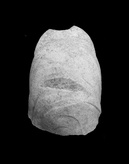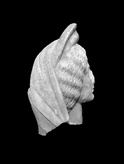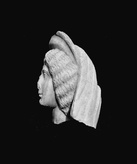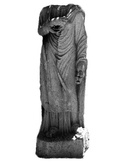- FundeFigs. IV. 60-63
Figs. IV. 60-63
Jerash, Department of Antiquities, no inv., excavation no. 20016/19
From Gerasa / Jerash, found on May 18th, 2016 in the exedra of the North Hall, square 63 locus 110, lying on the back side in north-southern extension.
White marble with oblique thick greyish-blue veins, medium grained, probably of Asia Minor origin.
Horizontally broken in the neck, nose chipped off, segment of the upper border of the diadem lost. On the back side is a horizontal stroke probably caused by a metal blade in order to decapitate the statue. Smaller bruises on the lips and traces of roots on the surface, especially on the right half of the face, otherwise well preserved. The fragment is entirely covered by a thin ivory patina. In the frontal hair, especially on the left side, traces of orange-red paint.
H 37 cm; W 32 cm; D 27 cm.
The female head is shown in frontal oriental with calm countenance, closed mouth and opened eyes. A slight turn to the left side may be only concluded by the assymetric drapery of the veil beside the neck. Despite individual traits appear reduced, the rendering of the mouth and eyes as well as the fashionable hairstyle identify the head more as a mortal rather than an idealized goddess. The face is regular outlined with a broad, rounded chin. The cheeks are flat and smooth. The bulky helmet-shaped coiffure is parted over the fore-head covers both ears down to the nape of the neck which is covered by the fabric on the mantle pulled over the rear head. On top of the skull sits a crescent shaped high diadem with raised borders. In their details, the physiognomic features as well as the coiffure with the drapery of the veil and the diadem testify experienced skillful sculptural workmanship.
The upper lip is apparently thin and curved underneath the filtrum while the lower is more fleshy. The nose merges into the rounded hand highly curved orbital arches with brows indicated by thin incised hatches. No tears sacks are indicated under the almond shaped eye balls which are surmounted by thin upper lids which over the upper segment of the circular engraved iris. The lacrimal corners are distinguished by the depth from the eye balls. The black of the eye is indicated by a bean-shaped dripped depression. The parted hair is carefully combed to each side by eight ondulated waves with concentric strands engraved to continuous groves. The frontal border of the coiffure toward the cheeks form a curved line elevated from the flesh of the face, and no curls are protruding under it. The rear part of the coiffure is covered by the fabric of the cloak which falls into oblique folds upon the shoulders. The back side of the head is neglected in workmanship as the drapery appears more schematic and graphic. At this side oblique traces produced by a rasp are visible. The crescent-shaped diadem has a concave shield with a thinner smooth upper frame.
End of 2nd or begin of 3rd century AD.
Bibl.: unpublished.






